What is Green Infrastructure?
Green infrastructure is a cost-effective, resilient approach to managing wet weather impacts that provides many community benefits. While single-purpose gray stormwater infrastructure—conventional piped drainage and water treatment systems—is designed to move urban stormwater away from the built environment, green infrastructure reduces and treats stormwater at its source while delivering environmental, social, and economic benefits.
Stormwater runoff is a major cause of water pollution in urban areas. When rain falls on our roofs, streets, and parking lots in cities and their suburbs, the water cannot soak into the ground as it should. Stormwater drains through gutters, storm sewers, and other engineered collection systems and is discharged into nearby water bodies. The stormwater runoff carries trash, bacteria, heavy metals, and other pollutants from the urban landscape. Higher flows resulting from heavy rains also can cause erosion and flooding in urban streams, damaging habitat, property, and infrastructure.
When rain falls in natural, undeveloped areas, the water is absorbed and filtered by soil and plants. Stormwater runoff is cleaner and less of a problem. Green infrastructure uses vegetation, soils, and other elements and practices to restore some of the natural processes required to manage water and create healthier urban environments. At the city or county scale, green infrastructure is a patchwork of natural areas that provides habitat, flood protection, cleaner air, and cleaner water. At the neighborhood or site scale, stormwater management systems that mimic nature soak up and store water.
Learn more about green infrastructure elements that can be woven into a community, from small-scale elements integrated into sites to larger scale elements spanning entire watersheds.
On this page:
- Downspout Disconnection
- Rainwater Harvesting
- Rain Gardens
- Planter Boxes
- Bioswales
- Permeable Pavements
- Green Streets and Alleys
- Green Parking
- Green Roofs
- Urban Tree Canopy
- Land Conservation
Downspout Disconnection
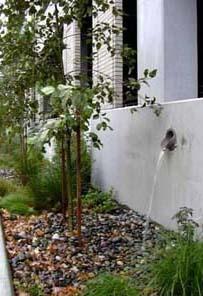 Water from the roof flows from this disconnected downspout into the ground through a filter of pebbles.This simple practice reroutes rooftop drainage pipes from draining rainwater into the storm sewer to draining it into rain barrels, cisterns, or permeable areas. You can use it to store stormwater and/or allow stormwater to infiltrate into the soil. Downspout disconnection could be especially beneficial to cities with combined sewer systems.
Water from the roof flows from this disconnected downspout into the ground through a filter of pebbles.This simple practice reroutes rooftop drainage pipes from draining rainwater into the storm sewer to draining it into rain barrels, cisterns, or permeable areas. You can use it to store stormwater and/or allow stormwater to infiltrate into the soil. Downspout disconnection could be especially beneficial to cities with combined sewer systems.
Examples
- Los Angeles Downspout Disconnection Program Exit
- Milwaukee Downspout Disconnection Exit
- Portland, OR, Downspout Disconnection Program
Rainwater Harvesting
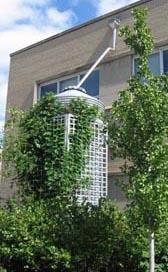 This rainwater harvesting system is adapted to the architecture of the building and its surroundings.
This rainwater harvesting system is adapted to the architecture of the building and its surroundings.
Rainwater harvesting systems collect and store rainfall for later use. When designed appropriately, they slow and reduce runoff and provide a source of water. This practice could be particularly valuable in arid regions, where it could reduce demands on increasingly limited water supplies.
Examples
Rain Gardens
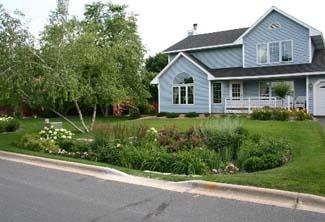 A rain garden can be beautiful as well as functional.Rain gardens are versatile features that can be installed in almost any unpaved space. Also known as bioretention, or bioinfiltration, cells, they are shallow, vegetated basins that collect and absorb runoff from rooftops, sidewalks, and streets. This practice mimics natural hydrology by infiltrating, and evaporating and transpiring—or “evapotranspiring”—stormwater runoff.
A rain garden can be beautiful as well as functional.Rain gardens are versatile features that can be installed in almost any unpaved space. Also known as bioretention, or bioinfiltration, cells, they are shallow, vegetated basins that collect and absorb runoff from rooftops, sidewalks, and streets. This practice mimics natural hydrology by infiltrating, and evaporating and transpiring—or “evapotranspiring”—stormwater runoff.
Examples
- Burnsville, MN, Stormwater Retrofit Study (PDF)(18 pp, 2.7 MB, About PDF) Exit
- 12,000 Rain Gardens in Puget Sound Exit
Planter Boxes
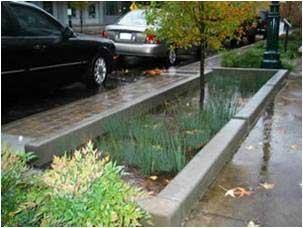 Planter boxes are an attractive tool for filtering stormwater as well as reducing the runoff that goes into a sewer system.Planter boxes are urban rain gardens with vertical walls and either open or closed bottoms. They collect and absorb runoff from sidewalks, parking lots, and streets and are ideal for space-limited sites in dense urban areas and as a streetscaping element.
Planter boxes are an attractive tool for filtering stormwater as well as reducing the runoff that goes into a sewer system.Planter boxes are urban rain gardens with vertical walls and either open or closed bottoms. They collect and absorb runoff from sidewalks, parking lots, and streets and are ideal for space-limited sites in dense urban areas and as a streetscaping element.
Examples
Bioswales
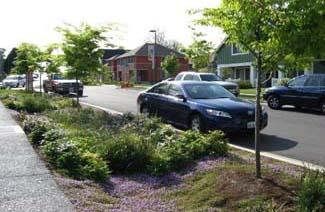 Bioswales are essentially rain gardens placed in long narrow spaces such as the space between the sidewalk and the curb. Bioswales are vegetated, mulched, or xeriscaped channels that provide treatment and retention as they move stormwater from one place to another. Vegetated swales slow, infiltrate, and filter stormwater flows. As linear features, they are particularly well suited to being placed along streets and parking lots.
Bioswales are essentially rain gardens placed in long narrow spaces such as the space between the sidewalk and the curb. Bioswales are vegetated, mulched, or xeriscaped channels that provide treatment and retention as they move stormwater from one place to another. Vegetated swales slow, infiltrate, and filter stormwater flows. As linear features, they are particularly well suited to being placed along streets and parking lots.
Examples
Permeable Pavements
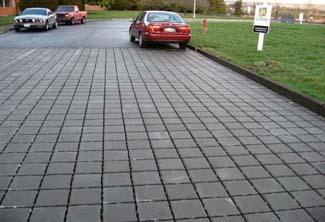 Permeable pavement is a good example of a practice that catches water where it falls.Permeable pavements infiltrate, treat, and/or store rainwater where it falls. They can be made of pervious concrete, porous asphalt, or permeable interlocking pavers. This practice could be particularly cost effective where land values are high and flooding or icing is a problem.
Permeable pavement is a good example of a practice that catches water where it falls.Permeable pavements infiltrate, treat, and/or store rainwater where it falls. They can be made of pervious concrete, porous asphalt, or permeable interlocking pavers. This practice could be particularly cost effective where land values are high and flooding or icing is a problem.
Examples
- Use of Pervious Concrete Eliminates over $260,000 in Construction Costs in Sultan, WA Exit
- Designing Impervious: A Minnesota city eschews storm drains for pervious streets Exit
Green Streets and Alleys
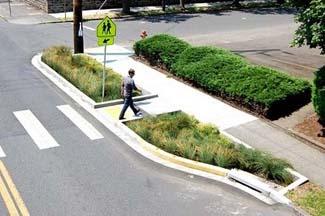 Green streets combine more than one feature to capture and treat stormwater.Green streets and alleys are created by integrating green infrastructure elements into their design to store, infiltrate, and evapotranspire stormwater. Permeable pavement, bioswales, planter boxes, and trees are among the elements that can be woven into street or alley design.
Green streets combine more than one feature to capture and treat stormwater.Green streets and alleys are created by integrating green infrastructure elements into their design to store, infiltrate, and evapotranspire stormwater. Permeable pavement, bioswales, planter boxes, and trees are among the elements that can be woven into street or alley design.
Examples
- EPA Region 3 Green Streets, Green Jobs, Green Towns (G3) Program
- Seattle Public Utilities GSI Projects
- Syracuse Green Street: Concord Place (PDF)(2 pp, 220 K, About PDF) Exit
- Los Angeles Green Street: Elmer Ave Exit
- The Chicago Green Alley Handbook (PDF)(24 pp, 3.7 MB, About PDF) Exit
Green Parking
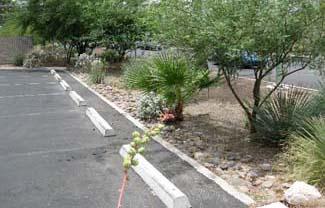 Parking lots are a good place to install green infrastructure that can capture stormwater that would usually flow into the sewer system. Many green infrastructure elements can be seamlessly integrated into parking lot designs. Permeable pavements can be installed in sections of a lot and rain gardens and bioswales can be included in medians and along the parking lot perimeter. Benefits include mitigating the urban heat island and a more walkable built environment.
Parking lots are a good place to install green infrastructure that can capture stormwater that would usually flow into the sewer system. Many green infrastructure elements can be seamlessly integrated into parking lot designs. Permeable pavements can be installed in sections of a lot and rain gardens and bioswales can be included in medians and along the parking lot perimeter. Benefits include mitigating the urban heat island and a more walkable built environment.
Examples
- Ipswich River Watershed Demonstration Project in Wilmington, MA
- Toronto Design Guidelines for “Greening” Surface Parking Lots (PDF)(40 pp, 9.6 MB, About PDF) Exit
Green Roofs
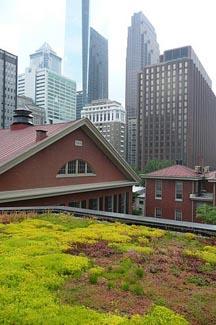 A green roof system atop a building helps manage stormwater and reduce energy costs for cooling. Green roofs are covered with growing media and vegetation that enable rainfall infiltration and evapotranspiration of stored water. They are particularly cost-effective in dense urban areas where land values are high and on large industrial or office buildings where stormwater management costs are likely to be high.
A green roof system atop a building helps manage stormwater and reduce energy costs for cooling. Green roofs are covered with growing media and vegetation that enable rainfall infiltration and evapotranspiration of stored water. They are particularly cost-effective in dense urban areas where land values are high and on large industrial or office buildings where stormwater management costs are likely to be high.
Examples
- King County, WA, Green Roof Case Study Report (PDF)(31 pp, 1 MB, About PDF)
- Green Roof and Wall Projects Database Exit
Urban Tree Canopy
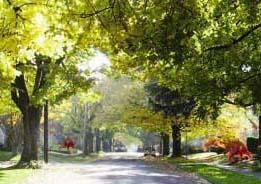 City trees, or tree canopy, soak up stormwater, provide cooling shade and help to slow traffic. Trees reduce and slow stormwater by intercepting precipitation in their leaves and branches. Many cities have set tree canopy goals to restore some of the benefits of trees that were lost when the areas were developed. Homeowners, businesses, and community groups can participate in planting and maintaining trees throughout the urban environment.
City trees, or tree canopy, soak up stormwater, provide cooling shade and help to slow traffic. Trees reduce and slow stormwater by intercepting precipitation in their leaves and branches. Many cities have set tree canopy goals to restore some of the benefits of trees that were lost when the areas were developed. Homeowners, businesses, and community groups can participate in planting and maintaining trees throughout the urban environment.
Examples
Land Conservation
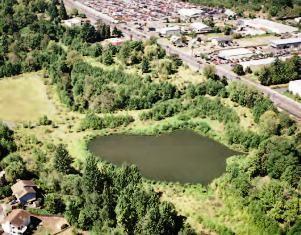 Land conservation is another good tool for communities to use for reducing the risks of stormwater runoff and sewer overflows. The water quality and flooding impacts of urban stormwater also can be addressed by protecting open spaces and sensitive natural areas within and adjacent to a city while providing recreational opportunities for city residents. Natural areas that should be a focus of this effort include riparian areas, wetlands, and steep hillsides.
Land conservation is another good tool for communities to use for reducing the risks of stormwater runoff and sewer overflows. The water quality and flooding impacts of urban stormwater also can be addressed by protecting open spaces and sensitive natural areas within and adjacent to a city while providing recreational opportunities for city residents. Natural areas that should be a focus of this effort include riparian areas, wetlands, and steep hillsides.
Examples
